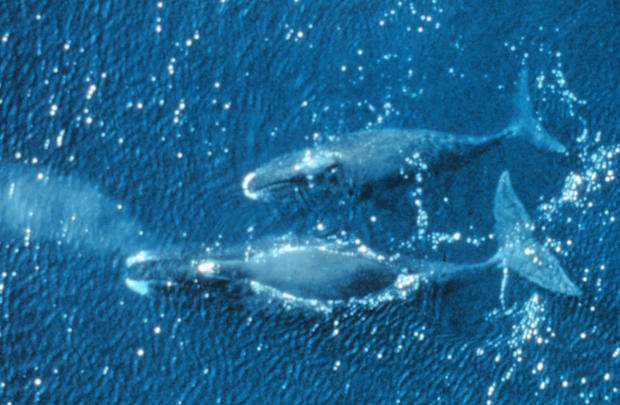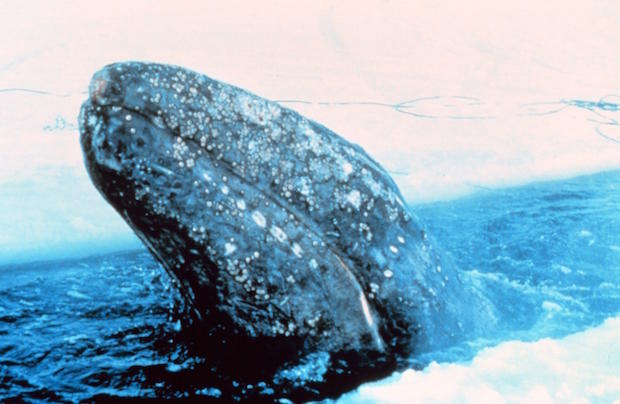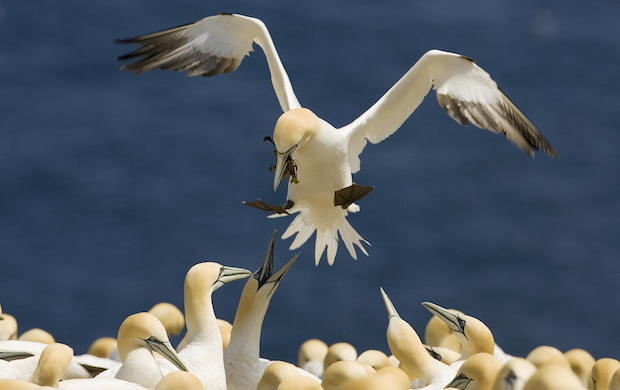Ocean species mix as sea ice melts, with unknown consequences
Melting Arctic ice is not only opening up new passageways for ships. Birds and marine species are also traveling to uncharted waters.
Seabird McKeon, a marine biologist with the Smithsonian Institution's National Museum of Natural History, and his colleagues compiled a list of the marine birds and mammals that have been spotted in the wrong ocean.
The results, published recently in the journal Global Change Biology, included species such as gray whales, killer whales, and seabirds like the northern gannet -- birds and mammals crossing into waters where they hadn't set foot or fin for thousands of years.
"Most marine mammals are hindered by thick sea ice -- they need access to the surface to breath. Diving seabirds also need access to open water. So for both of those groups, the reduction of sea ice means that they might be able to feed in areas where they couldn't before, or travel through areas previously blocked by ice," McKeon told CBS News in an email.
McKeon said that most of the sightings are coming in from citizen scientists. "Birders, whale watchers, and naturalists of all stripes who are getting outside, watching, recording what they see, and sharing that information with others," he said. "The oceans are big places, and there is no way for professional scientists to be watching everywhere."
It is too soon to tell if or when new populations of birds or mammals will become established in alternate oceans and the impact it will have on ecosystems. Elizabeth Alter, an assistant professor of biology at the City University of New York, and coauthor on the study, uses ancient DNA to answer questions about the impact of past climate changes on whale species. "It's useful to look at the past to give context for the present and future to be able to predict how species are going to respond to global warming," she said.
Below is a list of "vagrant individuals" that are swimming or flying their way into the wrong ocean.
Bowhead whales
Although bowhead whale populations exist on either side of the Northwest Passage, satellite tracking of tagged bowheads shows that populations have been moving between ocean basins. In the summer of 2010, two individual whales from two different populations were recorded feeding in the high Arctic at the same time. After ten days, the two whales retreated to their respective oceans. The occurrence "demonstrated the potential for increased ease of interpopulation exchange," the paper stated.
Gray whales
In the spring of 2010, a gray whale was spotted off the coast of Israel. Then in May and June of 2013, one or more gray whales was spotted off the coast of Namibia, in southern Africa. This was the first sighting of gray whales in the Atlantic in more than 200 years; they are normally found only in the Pacific.
Using ancient DNA and predictive habitat modeling, Alter and colleagues also found that gray whales traveled between ocean basins during climate warming that occurred in the late Pleistocene and early Holocene time period around 11,000 years ago.
Alter said that there would be ecosystem effects if gray whales recolonized the Atlantic. "Gray whales are ecosystem engineers," she told CBS News. "They scoop up mouthfuls of mud and act like bulldozers, moving around mud and resuspending nutrients so they can be used by other marine creatures and seabirds."
Killer whales
Killer whales, or orcas, are the most widely distributed marine mammal, found in all parts of the oceans except for the Arctic, where they were restricted by thick ice. In recent years however, killer whales have been found in ice-free areas of Hudson Bay, in northeast Canada.
"They're showing up in inlets and channels that a lot of marine mammals will avoid because the areas freeze," Alter told CBS News. Alter noted that killer whales populating the Arctic would "have a major ecological impact" because they might chase prey species out of their habitats. Killer whales have already been documented preying on beluga, narwhal, bowhead and at least four species of seal in Hudson Bay.
Shearwaters
The Manx shearwater is a small relative of the albatross. The known breeding range of this seabird is limited to the North Atlantic. However, the species has been increasingly observed in the North Pacific. Numbers increased so much in the 1990s that researchers think they might be breeding in the North Pacific now, too. Another species, the great shearwater, has also been seen, mostly in the summer months, including two sightings off the coast of California in the summer of 2013.
"While shearwaters are long-range migrants that may be capable of a southerly passage, the increasing frequency of out-of-range observations and the fact that they occur during the summer when sea ice is at a minimum suggest movement across the Northern Passages and Arctic Ocean," the paper stated.
The Northern Gannet
The northern gannet is a migratory seabird which spends winters off the southern coast of the United States and summers farther north. In March they migrate north to breeding grounds on northern sea cliffs along the coast of Atlantic Canada and the United States. This seabird's range is normally limited to the North Atlantic Ocean. "Sea ice presents an effective barrier because this species feeds on fish and needs access to open water when flying long distances," the paper stated. However, a northern gannet was observed in Alaska on two separate occasions in 2011. Then in April 2012, another northern gannet was spotted in the Farallon Islands off Northern California.
Due to its mode of feeding, researchers suggest that the bird most likely entered the Pacific via the Northwest Passages or the Arctic Ocean.
Auks
Auks are any of 22 species (21 still living) of diving birds in the Northern Hemisphere. Sea ice can impact the feeding of these birds so some are restricted to the Pacific. However, a number of Pacific species of auk, including long-billed murrelets, have been observed in the Atlantic in recent years. A tufted puffin was seen in European waters and Maine.
The bridled morph of the common murre, a seabird that represents nearly 50 percent of individuals at some North Atlantic colonies, was recorded in the Pacific for the first time in 2008.
"It is natural for animals to move into new areas that are available to them," Nathaniel E. Seavy, Ph.D., research director of the Pacific Coast and Central Valley Group for Point Blue Conservation Science, told CBS News in an email. "Biologists think that sometimes this happens because they are lost, and sometimes it happens deliberately as animals are searching for food or other resources. This process of moving into areas is called dispersal, and it is one ways that animals can survive as conditions change."
Seavy did however, note that the movement of species between ocean basins raises some questions. "My greatest concern is what these movements mean for how we conserve and manage our environment."
Seaducks
Subspecies of seaducks have also been recorded moving between opposite ocean basins. The Pacific subspecies of common eider was observed in Norway in 2014 and Newfoundland in 2005 while the Atlantic subspecies of that bird was found in Del Norte County, California.
"This is an example of how climate is changing the distribution of wildlife," Seavy said.
Researchers will continue to monitor changes in the wildlife community and to investigate the ecological and evolutionary consequences of ocean-basin exchanges. Researchers note that it is possible that some species may be able to establish themselves in new environments with relatively little disruption to other wildlife. But there will be cases where the arrival of new species will have a negative effect on ecosystems if they compete for food or other resources.
"That makes it important to continuing monitoring these changes," Seavy said. "And we will use this information to develop climate-smart strategies for conserving wildlife in a rapidly changing world."



